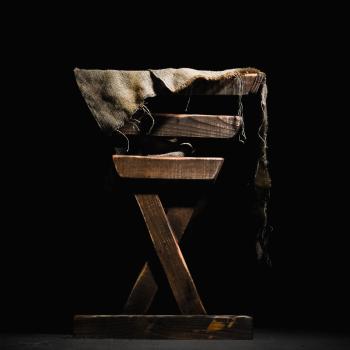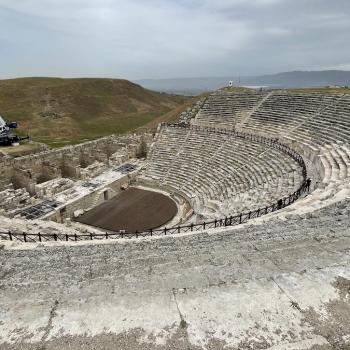
Much will be said this Christmas about whether or not there was an actual inn or if He was born in the home of a relative. We’ll speculate about the star the Magi followed; was it a super nova? We’ll even wonder if the choir of angels was a unique alignment of the planets or winged beings hovering in a night sky. We might question whether or not Jesus was born on December 25th or if it is actually a Pagan holiday. I attempt to sort these things out in Unwrapping the First Christmas. Whether successfully or not, you’ll have to be the judge.
Who Came to Bethlehem
But, will we stop and consider exactly who was born in Bethlehem more than 2,000 years ago? The majority of Christians in America believe He was simply God’s first created being and a great teacher but not God – both heresies dating back to the early church. So, naturally the truncated story of Joseph and Mary traveling to Bethlehem in fulfillment of not only a decree of Caesar but of prophecies regarding Jesus’ birth (Isa 7:14; Matt 1:1-17), becomes a quaint fable of a refugee family seeking asylum in a foreign land due to government persecution. A cute story that connects our modern day compassion for displaced people with the plight of the Holy Family.
However, to grasp the complete picture of the incarnation – the theological term for God become flesh – we have to ask, “who was incarnated?” Without this context, Jesus simply becomes a great teacher and prophet as many imagine Him to be. So, yes, there was no available room for Mary and Joseph, and Jesus was swaddled and laid in a manger. There were shepherds who encountered a heavenly host while tending their flocks. And there were eventually Magi from the East and a horrific infanticide. No doubt, Joseph also heard a warning from an angel so the family fled to Egypt.
Pause this Christmas
But take a moment and pause this Christmas to consider who it was that actually took on human form. Only John provides us with this picture and we often miss it for the apocalyptic depictions of angels and beasts, locust and multi-headed dragons. Yet the remarkable description of Jesus is no doubt the answer to His own prayer. And just like this form John describes, he alone records the conversation Jesus had with His Father before His suffering.
In its context, Jesus just finished the final meal with his disciples. Bible scholars call the exchange between Jesus and the twelve the “Upper Room Discourse.” In preparation for what would transpire, Jesus stops speaking figuratively to explain the events which were about to occur and how the disciples were to respond:
- One among them would betray Him and another would deny Him.
- Jesus charged them to love one another even though the world would hate them.
- The Holy Spirit would come to comfort them and give them words to speak.
- They were to abide in Jesus and He would give them joy.
- Some of them would be murdered by those who believed they served God.
- Jesus revealed the Father and now He was returning to the Father.
- Their sorrow would grow but eventually turn to joy.
He gave many instructions during this final meal to those who walked with Him for three years. And then He turned His face toward heaven to speak to His Father. We call it the high priestly prayer when Jesus prays for His followers, even us. And in the midst of His prayer, He makes a personal request, “And now, Father, glorify me in Your own presence with the glory that I had with You before the world existed” (John 17:5).
Jesus’s Glory
We might be tempted to think that Jesus’s resurrected form represented this glorification. A form similar to what Peter, James, and John experienced when they saw Jesus transfigured. But we would be mistaken by our human sensibilities to limit Jesus to our humanity. It’s this sensibility that keeps Jesus simply as a great prophet and teacher when in fact He is beyond what we are able to describe. John learned this in his encounter with the glorified Jesus.
And in the midst of the lampstands one like a son of man, clothed with a long robe and with a golden sash around his chest. The hairs of his head were white, like white wool, like snow. His eyes were like a flame of fire, his feet were like burnished bronze, refined in a furnace, and his voice was like the roar of many waters. In his right hand he held seven stars, from his mouth came a sharp two-edged sword, and his face was like the sun shining in full strength. (Rev 1:13-16)
This is not the Jesus of “The Chosen.” As endearing of a character Jonathan Roumie portrays, John the apostle describes the answer to Jesus’s prayer. And look at how he responds, “and when I saw Him, I fell at His feet as though dead” (Rev 1:17). The one who described himself as the disciple whom Jesus loved, fainted at the sight of the awesome figure he stood before. He had never experienced Jesus in His glorified form. And He frightened him.
Imagining Jesus
Perhaps we have trouble imagining Jesus as He truly is because we have grown up with the Jesus of the Christmas story. It could be that masterpieces like the Jesus of DaVinci’s “The Last Supper,” Raphael’s “The Disputation of the Holy Sacrament,” and Rembrandt’s “Christ in the Storm on the Sea of Galilee” enlivened our imagination about the Savior of the world. Or perhaps our image of Jesus formed after watching “The Jesus Film,” or “Last Temptation” (and dare I say again “The Chosen”).
All beautiful attempts to depict the Jesus of the gospels. But these are not the Jesus of today. We’re not going to meet the Jesus of “He Gets Us.” The Jesus we will eventually encounter is the same Jesus whom John encountered in Revelation 1. Considering that John, who learned from Jesus, walked alongside Him, and shared meals with Him, fell before Him in fear, it is likely that we too would do the same.
His Divine Radiance
Personally, if I’m honest, l’m scared. But I know something that John did not when he first saw the glorified Christ. The awesome figure he describes, even in all His glory, is still the compassionate, loving, and humble Savior that touches the hearts of all who encounter Him. Indeed, look at how Jesus reacts to John,
“But He laid his right hand on me, saying, ‘Fear not, I am the first and the last, and the living one. I died, and behold I am alive forevermore, and I have the keys of Death and Hades.’” (Revelation 1:17-18)
Jesus’s divine radiance does not overshadow His deep empathy and His unwavering commitment to show mercy. He still speaks to us and reaches out to touch us when we’re frightened, just like John experienced.
His teachings continue to be filled with wisdom, guiding humanity towards forgiveness, kindness, and understanding. His love transcends boundaries, embracing all people regardless of their social standing or past mistakes. Jesus exemplifies the perfect balance of power and tenderness, revealing the divine nature who is approachable and relatable. Even in His majesty, He remains the embodiment of compassion, a beacon of hope for a world in need of redemption.
A Response
Thus, we can exclaim along with the choir of elders and creatures surrounding the throne,
“Worthy are you, our Lord and God,
to receive glory and honor and power,
for you created all things,
and by your will they existed and were created.” (Revelation 4:11)
Christmas provides us the opportunity to reflect on the extent of God’s commitment to make Himself known to us. We could not know Him accurately if it were not for the incarnation. We could not understand His love for us if it were not first manifested in a manger. Ultimately, His life and relationships, even His death and resurrection make no sense if He first did not take on human form. However, if we keep Jesus in the Christmas story we will not truly understand who we will stand before one day.










